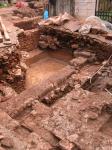Summary (English)
An archaeological watching brief over the works on the installation of the sewage network in the village of Lovrečica near Umag began on February 9, 2006. From March 16 to May 3, 2006, rescue excavation was conducted as a multi-layered Roman-period site was established in the sewer trenches. The most interesting part of the site is located around the parish church of St. Lovre (cadastral plot 1521/5).
The Roman-period villa rustica was embedded into the landscape following the natural terrain configuration and cascading towards the sea. It was in use from the 1st to the 4th century, and several architecturally distinct phases of construction and use of the villa have been established. Two pools, with solid wall structures and a multi-layer plaster finish with a very smooth surface, were found. The smaller pool was paved with the opus spicatum technique and preserved in excellent condition, with inner dimensions of 3.85 × 3.85 m. The large pool was covered with clay. Due to the size of the excavation area, it was not possible to determine its full dimensions. Additionally, a large number of tesserae, in different sizes and of different materials (from stone to ceramic), were found, along with remains of black, red and yellow frescoes, and remains of stone tiles made of green porphyry and marble.
In the Early Middle Ages, probably after the villa ceased to be used, graves were dug at its outer parts. The burial structures were made as gable roofs constructed of slates and tegulas, with almost no other architectural elements. A total of three early medieval graves without grave goods were excavated. They are laid in the north-south direction, with the head placed in the south. The backfill of these graves is a Roman-period rubble with construction ceramics and tesserae. Directly in front of the facade of today’s parish church, above the remains of the last phase of the Roman villa, graves from the 17th and 18th centuries were buried, containing the finds of devotional medals, coins, buttons, and rosaries (Narcisa Bolšec Ferri 2007, Hrvatski arheološki godišnjak 3/2006, 244–245).
- Narcisa Bolšec Ferri
Director
- Narcisa Bolšec Ferri
Team
- Kristina Gergeta
- Biljana Bojić
- Branko Mikušić
- Filomena Sirovica
- Maja Čuka
- Petar Dmitrović
Research Body
- Muzej grada Umaga






![Download [PDF]](/excavation/skins/fasti/images/results/download_sml.png)